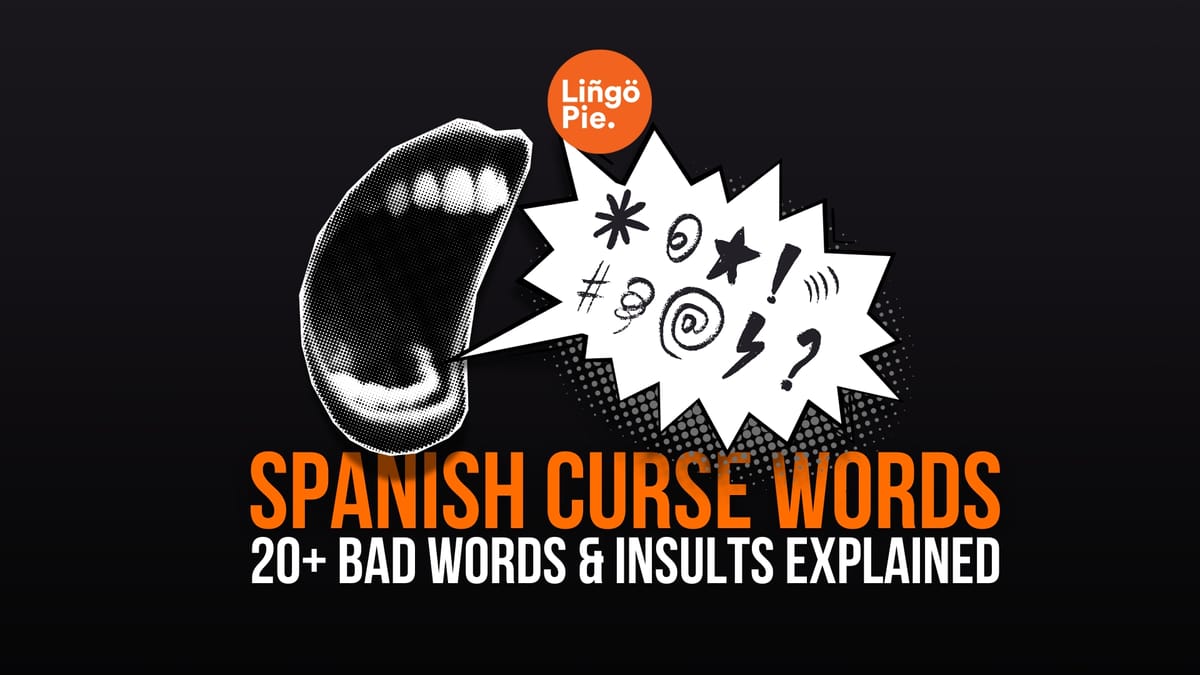Speaking Spanish isn’t about firing off perfect sentences at full speed. That’s not how real conversations sound. Native speakers pause. They hesitate. They throw in little words that give them time to think, soften what they’re saying, or just make speech flow naturally.
That’s where Spanish filler words come in.
Most English to Spanish word lists won’t teach you these. But if you want to sound natural, not robotic, you need them. Filler words give you a second to think, make your speech feel more relaxed, and help you sound more like a native speaker.
This guide will show you the most useful Spanish filler words, how real people use them, and when to sprinkle them into your conversations.
- Are You A Gabacho, Gringo, Or Güero? [Spanish Slang]
- 17 Best Shows To Watch To Learn Spanish On Netflix
- What’s The Best Way To Learn Spanish? [5 Best Tips]

How To Use Spanish Filler Words
The trick with filler words is knowing when to use them and when to leave them out. If you overdo it, you’ll sound unsure. If you avoid them completely, your Spanish can sound stiff and unnatural.
Here’s how to use them the right way:
Buy time to think
When your brain needs a second to catch up, throw in a filler. Instead of dead silence, say pues, este, or a ver. It sounds natural and gives you a second to plan your next words.
Soften your tone
Filler words help you sound less blunt. Spanish speakers use words like bueno or o sea to ease into opinions or soften corrections. If you say something too direct without them, it can feel a little harsh.
Sound more native
Even with perfect grammar, skipping fillers can make you sound like a textbook. Using common fillers makes your speech flow like real conversation, not a memorized script.
Match the situation
Casual chat? Use plenty of fillers. Formal setting? Use them sparingly. The more Spanish conversations you listen to, the faster you’ll pick up when and how to use them naturally.

Basic Spanish Filler Words
Not all filler words are complicated. In fact, some of the most useful ones are short, simple, and easy to remember. These basic Spanish filler words show up constantly in everyday speech. You’ll hear them in casual conversations, on TV shows, and even in interviews.
Pues: Buying time or softening your tone
Pues is one of the most flexible filler words in Spanish. It often means "well" or "so." You’ll hear it when people want to give themselves a second to think, change topics, or simply sound more relaxed. Use it at the start of a sentence or mid-sentence when your brain needs a moment to catch up or when you want to soften your tone.
Example: Pues, no lo sé (Well, I don’t know).
Example: Vamos a la fiesta, pues, ya veremos qué pasa (Let’s go to the party, well, we’ll see what happens).
O sea: Clarifying or restating something
O sea works like "I mean" or "that is to say." It’s great for explaining things in a different way or adding emphasis. You’ll hear it a lot in casual conversation when someone wants to make sure their point is understood. Use it before giving more detail or a clearer version of what you just said.
Example: Estudiamos todos los días, o sea, nos esforzamos mucho (We study every day, I mean, we put in a lot of effort).
En fin: Wrapping up or summarizing
En fin is used to bring a thought to a close or to summarize what you’ve just said. It’s similar to "anyway" or "in the end." You’ll often hear it at the start of a sentence when someone is about to move on or conclude their point.
Example: Hicimos todo lo posible, en fin, no pudo ser (We did everything we could, well, in the end, it didn’t work out).

Es decir: Adding clarification
Es decir means "that is" or "I mean." Spanish speakers use it to clarify what they’ve just said or to give an example. It sounds more natural than just repeating yourself and helps your listener follow your point more easily.
Example: Vamos a salir temprano, es decir, antes de las seis (We’re going to leave early, I mean, before six).
La cosa es que: Getting to the point
La cosa es que translates to "the thing is." It’s great for introducing the main point or issue you want to talk about. You’ll often hear it at the beginning of a sentence when someone wants to explain the real reason behind something.
Example: La cosa es que necesitamos hablar (The thing is, we need to talk).
Y tal: Adding a casual "and stuff"
Y tal is a very casual way to say "and so on" or "and stuff." Spanish speakers use it when they don’t want to list everything or when they want to keep the tone light and informal. It usually comes at the end of a sentence.
Example: Fuimos a la playa, y tal, pero no hacía buen tiempo (We went to the beach, and stuff, but the weather wasn’t good).
Pues sí: Agreeing or confirming
Pues sí means "well, yes." It’s a natural way to confirm or agree with someone, with a little more emphasis than just sí alone. You’ll hear it a lot when people want to sound friendly or confident in their reply.
Example: ¿Vas a la fiesta esta noche? — Pues sí, claro que sí (Are you going to the party tonight? — Well, yes, of course).

En serio: Expressing seriousness or surprise
En serio means "seriously." Spanish speakers use it to show they’re being sincere, or when they react to something surprising or hard to believe. You’ll hear it a lot when someone is confirming something unexpected, or adding emphasis to a statement. It usually comes at the end of a sentence or as a response.
Example: ¿Ganaste la lotería? — ¡Sí, en serio! (Did you win the lottery? — Yes, seriously!).
Pues nada: Downplaying or moving on
Pues nada roughly means "well, anyway" or "well, it didn’t work." It’s a very casual way to downplay something or to signal that you’re moving on from a failed attempt or minor event. You’ll hear it when someone wants to wrap up a story or brush off a small failure.
Example: Intenté arreglar la impresora, pero pues nada, no funcionó (I tried to fix the printer, but, well, it didn’t work).
Es como: Making comparisons
Es como means "it’s like." Spanish speakers use it all the time when comparing something to another thing or describing something by analogy. It helps make your speech more vivid and relatable. You can use it in the middle of a sentence when explaining how something felt, looked, or seemed.
Example: La película era es como un sueño, lleno de colores y emociones (The movie was like a dream, full of colors and emotions).

En plan: Describing actions or giving an example
En plan is one of the most common fillers among younger Spanish speakers. It roughly works like the English "like" when you’re describing actions or giving examples. It makes your speech sound casual and conversational. Use it mid-sentence to introduce an action, example, or feeling.
Example: Salimos anoche, en plan, a dar un paseo (We went out last night, like, for a walk).
Literalmente: Emphasizing that something is true
Literalmente means "literally." Spanish speakers use it to stress that what they’re saying is not an exaggeration, but an actual fact. You’ll often hear it when someone wants to be clear that their words should be taken exactly as stated. Use it in the middle of a sentence, right before the thing you want to emphasize.
Example: Me comí literalmente toda la pizza (I ate literally all the pizza).
A ver: Showing expectation or introducing something new
A ver literally means "let’s see," but in conversation it works as a flexible filler. Spanish speakers use it to introduce an action, suggest trying something, or transition to a new topic. It’s very common at the start of a sentence when someone is about to do something or when they’re thinking out loud.
Example: Vamos a probar ese nuevo restaurante, a ver qué tal (Let’s try that new restaurant, let’s see how it is).
Bueno: Starting a thought or shifting the conversation
Bueno is one of the most common filler words in Spanish. It often means "well" and is used at the start of a sentence when you’re about to give an opinion, respond, or shift to a new topic. You’ll hear bueno all the time — it helps your speech sound more natural and gives you a moment to think.
Example: Bueno, creo que es hora de irnos. ¿Qué opinas? (Well, I think it’s time to leave. What do you think?).

When Not To Use Filler Words
Filler words make your Spanish sound more natural—but only if you use them in the right situations. Overdoing it or using them in the wrong place can make you sound unsure, unprofessional, or even a little annoying.
Here’s when to hold back:
- Formal settings
- Written Spanish
- Overuse
- When your message needs to be clear
If you’re giving instructions or explaining something important, avoid fillers that might add noise or make your point less sharp. Keep it simple and direct.
Learn Spanish With Lingopie
The best way to get comfortable with Spanish filler words is to hear them in real conversations. No textbook or English-to-Spanish words list will show you how native speakers actually use pues, o sea, en plan, and the rest.
That’s where Lingopie helps. You watch Spanish shows and movies with interactive subtitles, so you can see how these little words work in real life. Click any word, learn it in context, and start sounding more natural.
Want your Spanish to flow like real Spanish? Try Lingopie and see the difference.
FAQs Regarding Common Filler Words
Understanding and mastering filler words is key to fluent communication. In this section, we provide answers to common questions relating to the importance of these phrases in Spanish conversation.
What are common Spanish filler words?
Common Spanish filler words include "pues," "o sea," "en fin," and "es decir." Native Spanish speakers use these expressions to add fluency, clarify points, and convey a more natural conversational tone.
Is como a filler word?
Como can be a filler word in some cases, especially in casual speech when used to introduce comparisons or add hesitation. For example: Estaba, como, muy nervioso (I was, like, really nervous). But como also functions as a regular word meaning "like" or "as," so it depends on context.
What are Puerto Rican filler words?
In Puerto Rican Spanish, common filler words include este (uh), tú sabes (you know), pues, o sea, and mano (short for hermano, used as "bro" or "dude"). You’ll also hear nítido and chévere used casually to express approval or coolness, though they’re not pure fillers.
Is año a filler word?
No, año (year) is not a filler word. It’s a regular noun meaning "year." If you’re hearing it used in casual conversation, it’s being used normally, not as a filler.




![Why Memorizing Spanish Words Won’t Make You Fluent [Tips]](/blog/content/images/2025/06/how-to-practice-spanish-vocabulary.jpg)

![30+ Modern English Slang Terms For Money [Guide]](/blog/content/images/size/w300/2025/06/Slang-term-for-money.jpg)
![5 Official Spanish Language Tests To Show Your Proficiency Level [Guide]](/blog/content/images/size/w300/2025/06/Spanish-Language-Tests.jpg)

![Why Memorizing Spanish Words Won’t Make You Fluent [Tips]](/blog/content/images/size/w300/2025/06/how-to-practice-spanish-vocabulary.jpg)